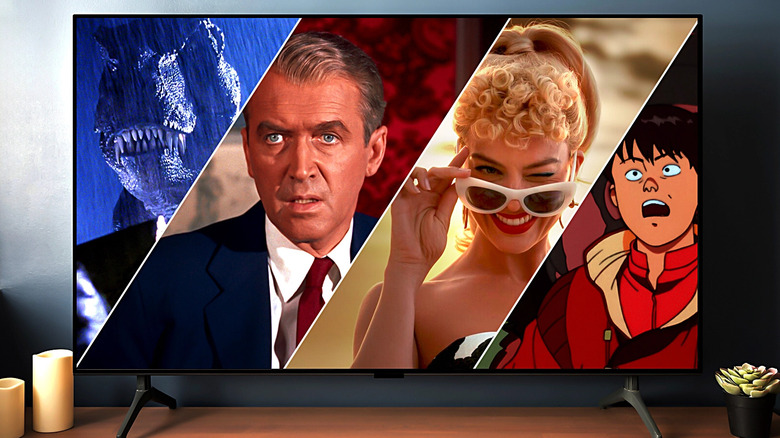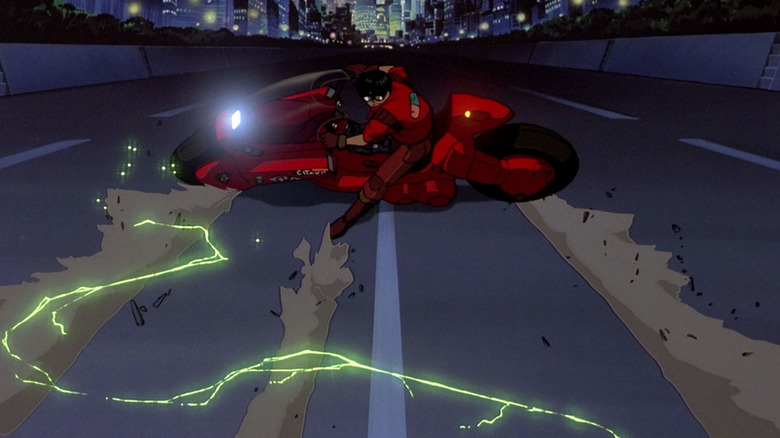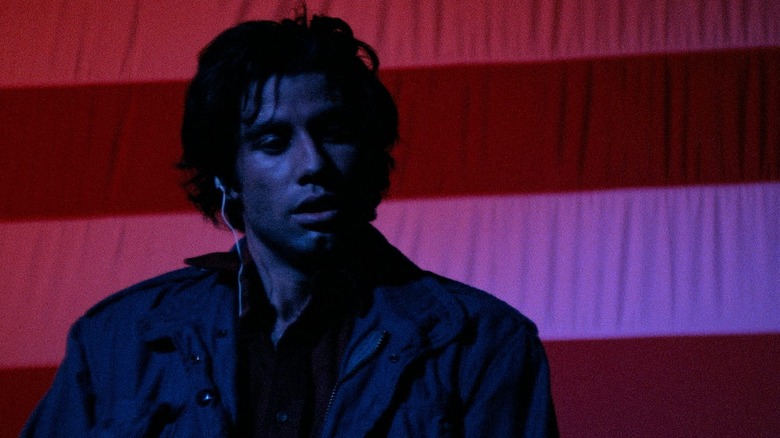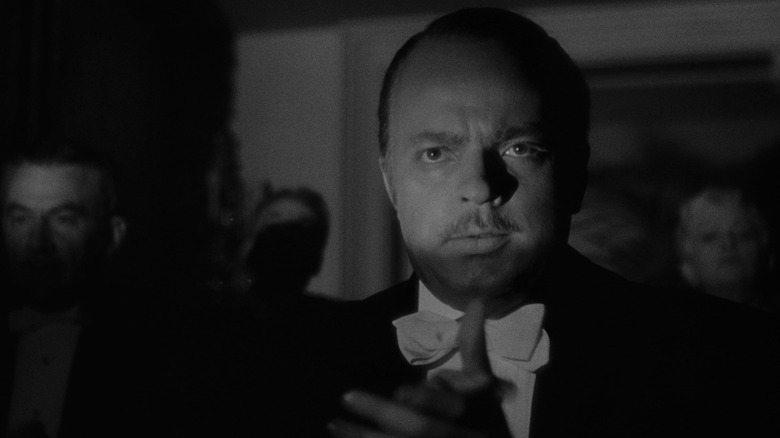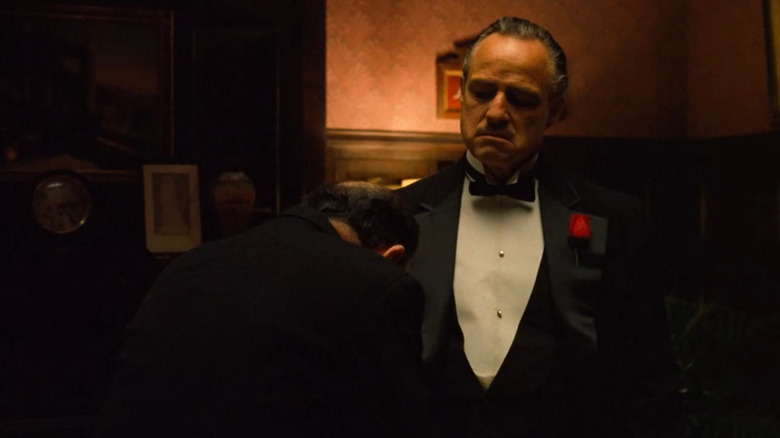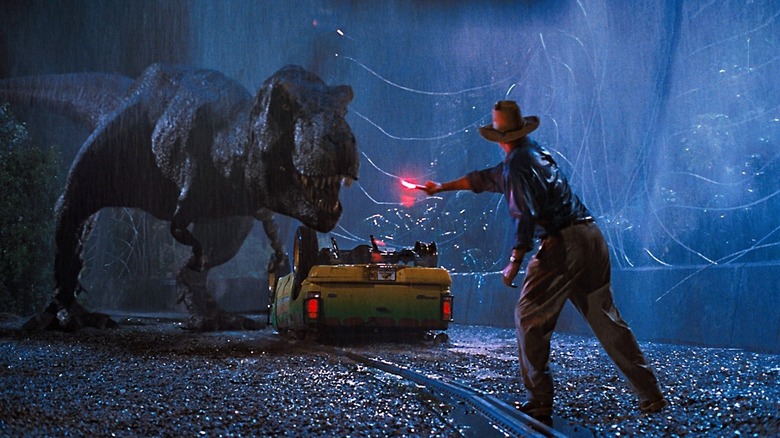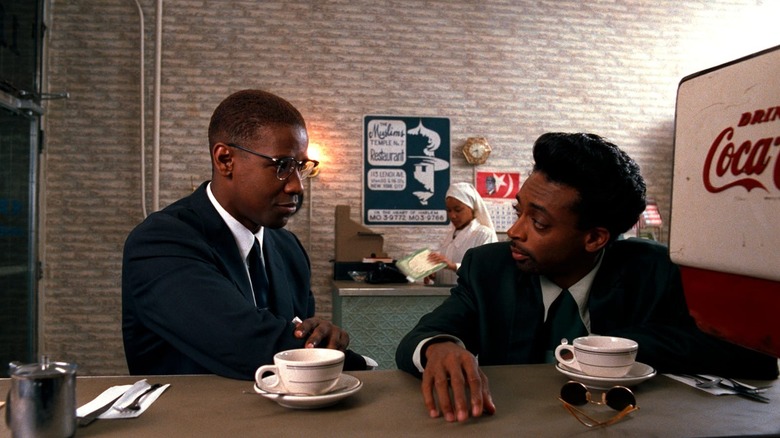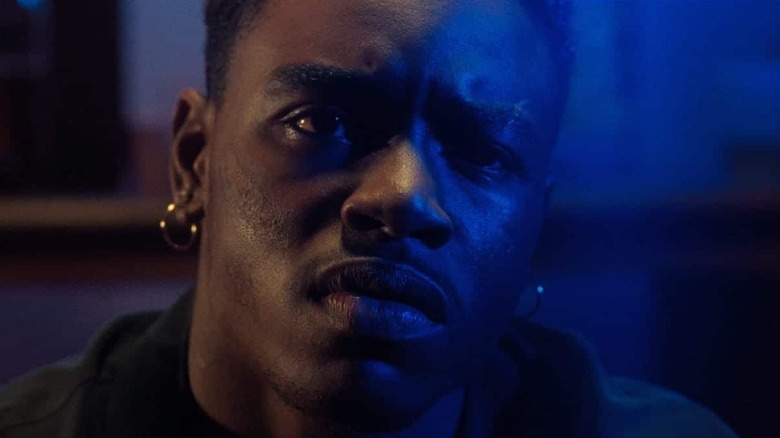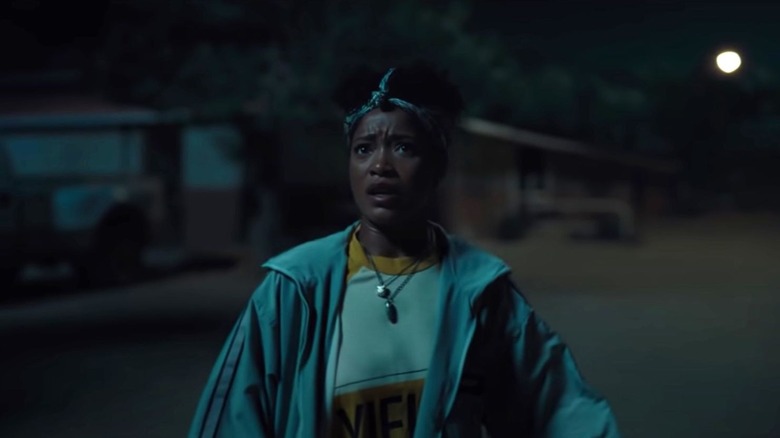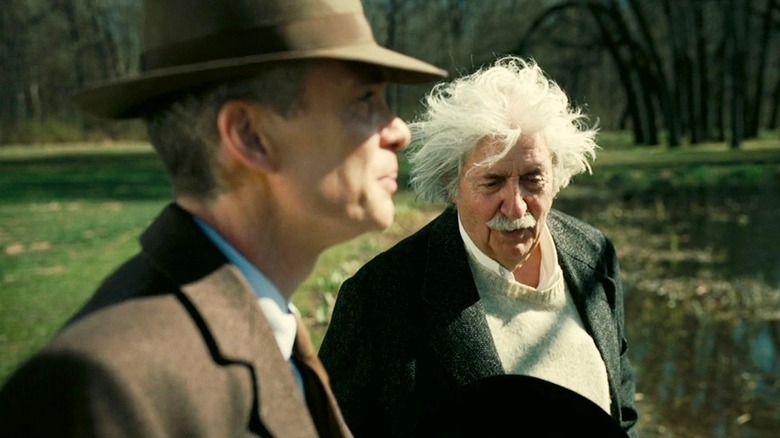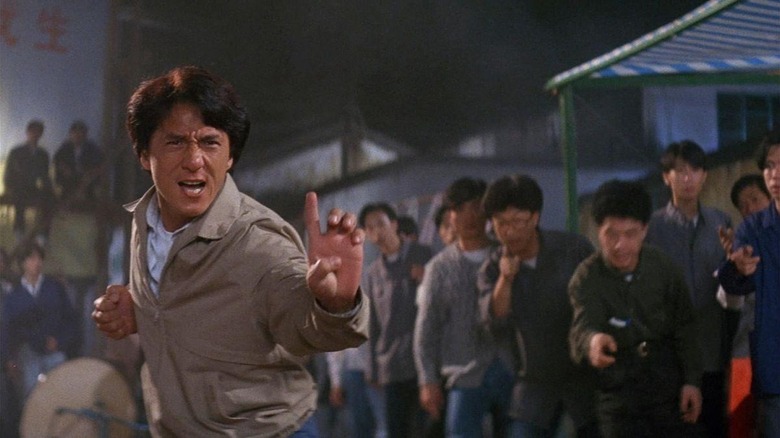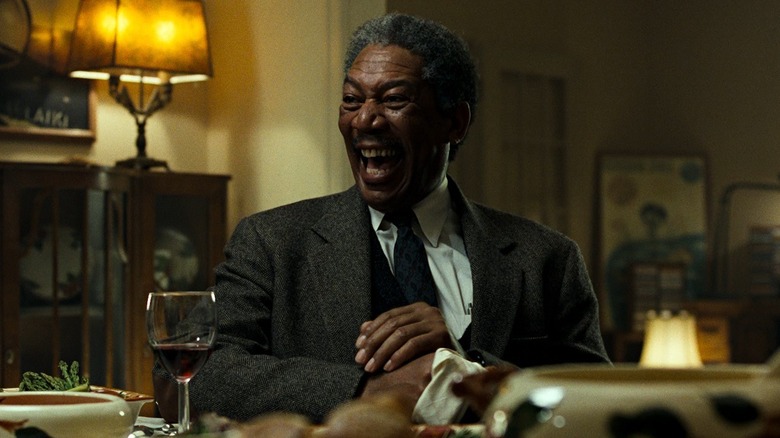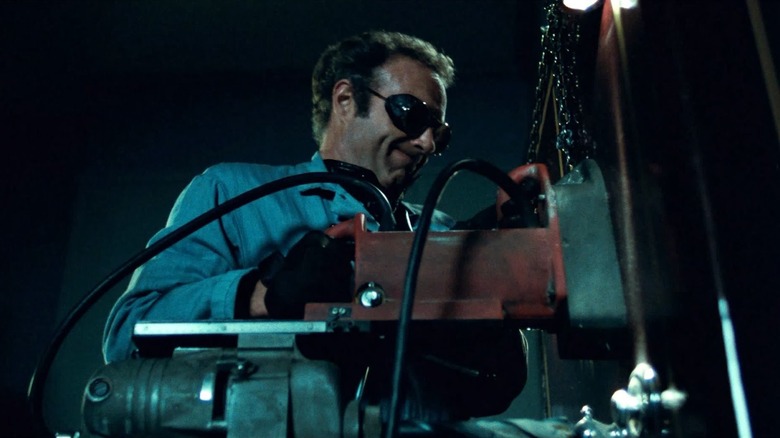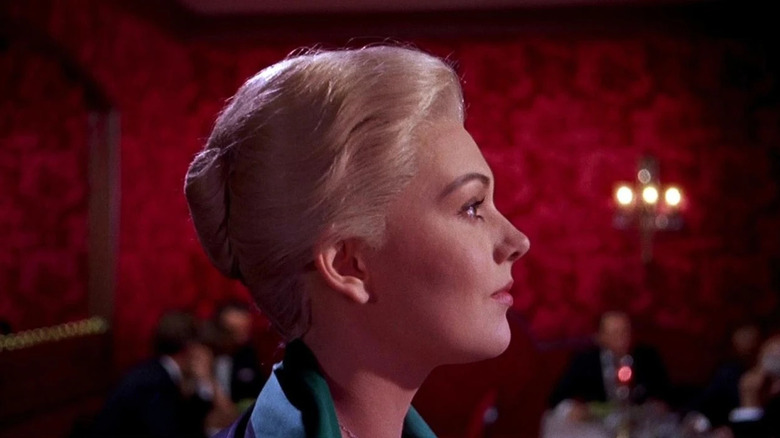15 Movies You Need To Watch On Your New OLED TV
We may receive a commission on purchases made from links.
I am an OLED proselytizer. I will shout about the benefits and pure pleasures of this kind of television from the rooftops. If you're trying to build the ultimate home theater, I highly encourage going for it. And if you already have an OLED and are looking for the best stuff to showcase it, well, you've got a wonderful-looking future ahead of you.
What makes the OLED television so wonderful? "OLED" stands for "organic light-emitting diode," and to avoid the risk of turning this into a scientific manual, that basically means a television using such technology has a wider range of colors to display because its "black" is a true black. Unlike other TV systems like LCD, an OLED simply presents no information when something is supposed to be "black," giving everything a deeper and richer image. And if none of this makes sense to you, well, you'll know it when you see it.
Here then, for the true believers and skeptics alike, are 15 movies you need to watch on your new OLED TV. You'll never go back, I promise.
Akira
Animation is a great medium to showcase the pleasures of your OLED TV. And while contemporary CG or 3D animated movies will definitely wow on your system, there's nothing like a traditional, hand-drawn movie to appreciate the television's interpretation of a wide-varying color scheme, especially the inky blacks. So why not give the anime classic "Akira" a spin?
The 1988 sensation directed by Katsuhiro Otomo takes place in a dystopian, cyberpunk Japan, in a city called Neo-Tokyo. Badass biker Kaneda (Mitsuo Iwata) is best friends with Tetsuo (Nozomu Sasaki), an unstable man who gains unfathomable psychic abilities that threaten not just Neo-Tokyo but the entire fabric of reality.
The visual language of "Akira" is incredible, imaginative, and unbeatable, to the point where it actually resulted in 50 new shades of color. Experiencing it on a great OLED TV is a profound experience, one that immerses the viewer into its propulsive and often terrifying ambience.
Barbie
"Barbie" is one of the most colorful movies in recent memory, a wonderful antidote to the sometimes dreary trend of desaturating and washing out color temperatures. Its gorgeous use of stylized pinks (duh) pop with delicious clarity on an OLED television, and that's before we get to the dream ballet of "I'm Just Ken," a demo-ready showcase.
Greta Gerwig's comic masterpiece concerns a real-life Barbie (Margot Robbie) who starts to achieve a sense of existential sentience that concerns the other, happy-go-lucky residents of Barbieland, especially the doofy Ken (Ryan Gosling). When she travels to the real world and meets a struggling mother and her daughter (America Ferrara and Ariana Greenblatt), she just might find the real, beautiful purpose behind her existence.
Before this film, Gerwig was primarily known for talky, grounded pictures like "Lady Bird" and "Little Women" — both gorgeously shot, to be clear, but nothing near the blown-out fantasia of "Barbie." It's the result of a filmmaker breaking every single Hollywood rule about toy movies, playing like OLED eye candy.
Blow Out
I adore watching films from the late 1970s and early 1980s on my OLED. These films were clearly shot on gorgeously grainy film stock and lit with precision by all manner of incredible cinematographers. As an example, let's take one of my all-time favorite films, Brian De Palma's 1981 paranoid thriller "Blow Out" (especially when watched on Criterion's wonderful 4K package).
"Blow Out," shot by Academy Award winner Vilmos Zsigmond, stars John Travolta as a sound designer for crappy horror films. When out at night making field recordings, he accidentally captures the audio of an assassination of a prominent political candidate. From that point on, his life takes a series of cataclysmic turns involving cover-ups, tragic romance, and more murder.
De Palma is a visually ostentatious filmmaker, and he and Zsigmond throw every cinematic trick they can at the story's wonderful set pieces, with split-screens, split-diopter shots, long camera tracks, and more, all gorgeously rendered with beautiful colors and chunky-ass grain.
Citizen Kane
Black and white films are stunners on OLED systems. OLED televisions are wonderful at rendering the colors "black" and "white" because their blacks typically involve producing no light information at all, giving the image a gorgeous sense of deep contrast. You've got your pick of the litter for these types of films, but let's start with an undeniable classic, also available on Criterion 4K.
"Citizen Kane" is, inexplicably, the directorial debut of Orson Welles, who invented many cinematic techniques we now take for granted while filming. Welles stars as Charles Foster Kane, a fictionalized version of real-life media magnate William Randolph Hearst. The film, with its opening scene that caused chaos in the theater, begins with the dying man's last word, "Rosebud," and then paints a picture of his entire life. Idealism curdles into capitalism, love ices over into brittle distrust, and human connection turns into a prison of one's own making.
It's an American tragedy made with brio and empathy, one that will turn the head of anyone walking by your TV. Watch, posthaste.
The Godfather
How about another one of the greatest films ever made, shot by one of the most influential cinematographers, Gordon Willis?
When making "The Godfather" in 1972, Willis and director Francis Ford Coppola got a lot of flak for how dark and shadowy the dailies looked (one of many things Coppola had to fight for). Watching it on an OLED TV, however, it's clear how intentional and gorgeous these visuals are. Characters dip in and out of shadows, representing of their shifting descent in and out of their criminal and moral underworlds, with the OLED's color abilities working overtime.
As for the film itself, beyond its status in pop culture iconography, it remains about as perfect as cinema can get, feeling both timeless and contemporary. It follows young Michael Corleone (Al Pacino) as he slowly transforms from a meek, family mafia outsider into a vicious boss capable of succeeding Don Vito (Marlon Brando). It's three hours long, and not one minute, not one frame, is wasted. I can think of few better uses of your television.
Jurassic Park
What's your favorite Steven Spielberg movie? He's made so many bangers and classics that there pretty much isn't a wrong answer (unless you pick "Ready Player One," in which case, shame on you). For my money, though, I go "Jurassic Park" every time, especially when experiencing it in 4K on my OLED TV.
In the fewest possible words: Dinosaurs exist again, and try to eat everyone! But to use just a few more: Doctors Alan Grant (Sam Neill) and Ellie Satler (Laura Dern) visit the soon-to-open Jurassic Park, an experimental island where the enterprising John Hammond (Richard Attenborough) keeps and plans to show off his resurrected, cloned dinosaurs. Obviously, the best of Hammond's intentions go awry, and Alan and Ellie must escape the clutches of these ferocious beasts while saving their fellow visitors in the process.
"Jurassic Park" is a stunning film, and the colors of the jungle, in both day and night, pop vividly on an OLED system (not to mention Dennis Nedry's shirt). If it's somehow your first time watching it, enjoy!
Malcolm X
Another Criterion 4K banger, "Malcolm X" is one of Spike Lee's masterpieces, decades in the making, an over three-hour film that zips by with urgency and cinematic invention.
It stars Denzel Washington as the activist Malcolm X, and its screenplay is based on Malcolm X and Alex Haley's collaborative work "The Autobiography of Malcolm X." While it dramatizes the key moments of Malcolm X's life, such as his relationship to the Nation of Islam, his many fiery speeches, and his assassination, it bypasses the typical, staid pitfalls of the biopic by force of will and invention.
I love watching this film on an OLED TV because Lee and his DP Ernest Dickerson (himself a great filmmaker) use mixed media and widely varying color temperatures, shifting between film stocks and black and white imagery depending on what they're trying to communicate. It's basically a CrossFit regimen for your television, giving it every kind of filmmaking mode to interpret with accuracy and alacrity.
Mandy
Panos Cosmatos' psychedelic horror masterpiece "Mandy" has much to recommend. Nicolas Cage snorting cocaine in his underwear, chainsaw fights with leather daddy demons, Andrea Riseborough laughing bitterly in the face of Linus Roache's full-frontal nudity — the hard left turns in "Mandy" offer many pleasures. But its dark and colorful visuals, thanks in part to DP Benjamin Loeb, make it an immediate and obvious recommendation for an OLED TV.
"Mandy" stars Riseborough in the title role and Cage as her beloved life partner. When Roache's cult kidnaps and kills Mandy due to some misguided prophecy, Cage loses his ever-loving mind and goes on a metaphysical, Lovecraftian rampage of revenge.
The film juggles many tones with patience and aplomb, thanks in large part to its performers' emotional grounding in the thesis of a reconstruction of the self. And it is utterly gorgeous to look at, the shadowy and neon-soaked images feeling like a grotesque velvet painting come to life on an OLED.
Menace II Society
When I watched "Menace II Society" on Criterion's 4K package on my OLED, I was gobsmacked. The film is stuffed with upsetting and provocative imagery from its first, violent scene. But it's all rendered with kinetic imagination by its directors, Albert and Allen Hughes, making its sequences of misery feel like test balloons for genre or blockbuster fare. That's a fascinating paradox to exist in, and the OLED experience widens this chasm even further, making it a harrowing but invigorating watch.
Caine (Tyrin Turner) and O-Dog (Larenz Tate) are two young men making their way through the Watts neighborhood in Los Angeles. Throughout their maturation, they've struggled with parental neglect, drug addiction, and violence — all difficulties that they begin to perpetuate themselves. Can these so-called menaces to society find their way through the madness into the hope for a better future? Or are some circumstances such self-fulfilling prophecies that advancement is impossible?
Nope
Jordan Peele and DP Hoyte van Hoytema, both Oscar-winners, went bonkers mode on "Nope."
The sci-fi-horror-Western-blockbuster-satire was shot using a combination of IMAX 65mm film (a fact that actually becomes a plot point with the film's cinematographer character) and inventive rigs to visually upgrade "day for night" footage, where scenes shot during the day are treated to look as though they were shot at night. As such, watching this sucker on an OLED television is a treat, even as you're watching some deeply upsetting imagery (not to mention hearing its spectacular sound design).
"Nope" stars Keke Palmer and Daniel Kaluuya as siblings who run their late father's (Keith David) horse ranch, often renting out their animals to movie shoots. But when an unidentified flying object seems to start sucking things into the sky, the pair must use their knowledge of capturing the uncapturable to find the truth.
On an OLED, the nighttime footage strikes this wonderful balance of accuracy in its darkness while staying accessibly visible to its viewers. It's beautiful visual grammar amplified by your TV.
Oppenheimer
The second half of the Barbenheimer double feature, "Oppenheimer" comes to us from Christopher Nolan and the aforementioned Hoyte van Hotema, both of whom won Oscars for their work.
For those who somehow don't know, the film is an intense and epic study of J. Robert Oppenheimer (Cillian Murphy), considered the father of the atomic bomb. Nolan's screenplay shows us the science that led to such destruction, the burden of conscience that soon followed, and the ensuing political backstabbing by Oppenheimer's former allies. It's a monumental work from a director who seems to only make monumental work.
And on an OLED? Forget about it. You may have missed the 70mm IMAX screenings that blew up every theater in 2023, but to watch the picture on your OLED (preferably on the 4K disc, to get that IMAX aspect ratio switching) is the closest you'll get to replicating the experience. The colors are vivid and often dangerous-feeling, and the film grain makes everything feel tactile. It's a showpiece title, even if James Cameron takes issue with it.
Police Story 3: Supercop
Jackie Chan's "Police Story" trilogy contains some of the best action filmmaking and performing ever put to celluloid. But I'll shout out the third entry, often referred to simply as "Supercop," as blowing my mind on my OLED system, especially watching the 88 Films 4K disc.
Chan reprises his role as the similarly named Chan Ka-Kui, a well-regarded Hong Kong police officer sent on an undercover mission in mainland China. There, he teams up with the similarly talented and ass-kicking officer Jessica Yang (Michelle Yeoh, powerful even during a stunt gone wrong), and the two must put their wits and fists together to take down a vicious drug lord (Kenneth Tsang).
The 4K, HDR makeover of the 1992 film is revelatory, especially for those who, like me, got to know "Supercop" on VHS or TV reruns. Its colors are vibrant, whether depicting lush green jungles, cold gray cityscapes, or the hot orange of massive explosions. This is a fun, fun watch to put your system through.
Se7en
David Fincher loves him some darkness, both aesthetically and thematically. He may have hit his peak for both with 1995's "Se7en," the classic crime thriller set largely in rainy sludge or darkened rooms of mayhem.
Detective Somerset (Morgan Freeman) is jaded and beaten down by his years of fighting crime with no karmic sense of actual justice to show for it. His new partner, Detective Mills (Brad Pitt), is more idealistic, and a little hot-headed. The mismatched pair must try and solve a set of serial murders that seem to follow a biblical theme: Each death is committed as a result of one of the seven deadly sins.
Like "The Godfather," Fincher and Darius Khondji's photography also spooked studio execs with the literal darkness of their dailies (once again, thank the movie gods for stubborn filmmakers), a look that is intensified and appreciated just as much on an OLED system. The film's iconic final sequence looks incredible as well, blazing the viewer with a suddenly bright, orange desert landscape.
Thief
Michael Mann's oeuvre is full of visually striking titles, often taking place in urban settings at night, playing with shadow and color in gorgeous, melancholy, and evocative ways. To sample how his style can really pop on your OLED TV, check out his debut, 1981's "Thief" (and especially check it out on the Criterion 4K disc).
James Caan stars as Frank, a professional thief in the Chicago area, a role that changed Caan's life for better and worse. Frank desperately wants to go straight and stop hitting safes. He wants a life of love and fulfillment, especially with the beguiling Jessie (Tuesday Weld). But if you've seen any crime or heist movie, you know it's not that easy to just walk away. Frank's got at least one last job to do.
Mann's procedural but dreamlike vision of this criminal job, scored with a sultry edge by Tangerine Dream, looks intoxicating and seductive on an OLED. The nighttime sequences, of which there are many, feature neon reflections off wet pavement, giving the dark images life and light.
Vertigo
To end this list, I think it would behoove us to recommend what some may call the pinnacle of Alfred Hitchcock's illustrious career: 1958's "Vertigo."
James Stewart (Jimmy, if you're nasty) stars as Scottie Ferguson, a retired detective who's developed a devastating fear of heights and symptoms of vertigo (not far off from Alfred Hitchcock, apparently). But when he's hired as a private investigator chasing down an unusually behaving woman (Kim Novak), he must face his fears head-on by looking down.
Hitchcock and cinematographer Robert Burks lensed and finished the film in glorious Technicolor, that bygone range of color film that makes everything feel heightened. They also invented and used the now-ubiquitous dolly zoom to communicate Scottie's vertigo effects.
As such, it is a visual feast, a living testament to the OLED system's ability to preserve classic cinema history. Its Technicolor splendor will make you detest the day color correctors invented the LUT, and its dolly zooms just might give you secondhand vertigo.
